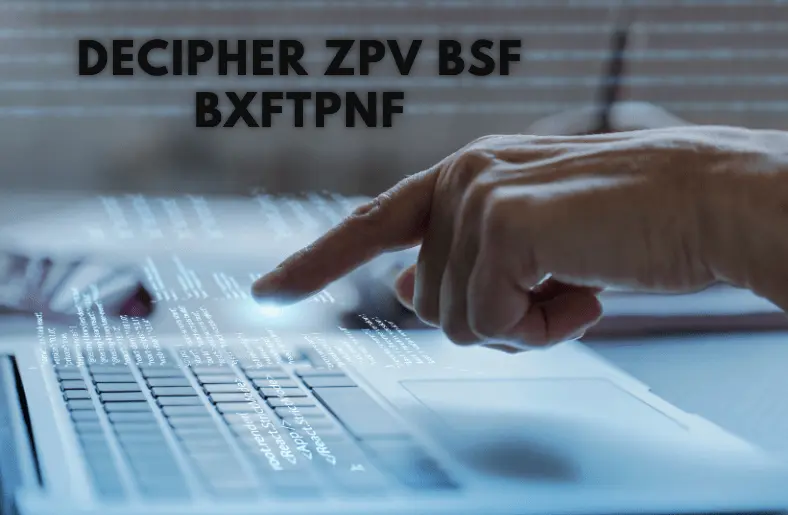Ciphers have always intrigued people. From ancient codes to modern encryption, their appeal is timeless. Today, decoding messages feel like unraveling hidden secrets. One such mystery is the phrase “Decipher ZPV BSF BXFTPNF.” At first glance, it seems like random letters, but with the right approach, it reveals something special. We will decode this sentence and examine the operation of simple ciphers in this post. Let’s investigate the fascinating field of cryptography.
What is a Cipher? Understanding the Basics
Information can be encrypted using a cipher. In essence, it jumbles information to conceal its actual meaning. By using a predefined system, a cipher ensures that only authorized parties can understand the message. The process of encoding relies on replacing or shifting letters in a predictable way.
Ciphers have been around for centuries. Over time, they’ve evolved into complex systems used in modern encryption. While some ciphers are simple, others require advanced methods. Despite their complexity, all ciphers aim to secure communication, ensuring that the message remains confidential. Understanding ciphers opens the door to the fascinating world of encryption.
Decoding the Simple Substitution Method
One of the earliest and most basic encryption methods is the Caesar cipher. Every letter in the message is moved by a predetermined amount. For example, with a shift of three, “A” would become “D” and “B” would become “E”. This method is easy to understand and apply, making it ideal for beginners.
The Caesar cipher has historical significance despite its simplicity. It was famously used by Julius Caesar for secure military communication. However, it’s not very secure by modern standards. Still, learning this cipher provides a foundation for understanding more complex encryption systems. It’s an essential step in learning cryptography.
Step-by-Step Guide
Recognizing the Cipher
Start by identifying that the phrase uses a simple substitution cipher. This cipher shifts letters by a fixed amount. You will decode the message using this basic rule, which makes it easier to crack.
Shifting Letters Backward
“Decipher ZPV BSF BXFTPNF” can be decoded by moving each letter one position backward. For instance, Z becomes Y, P becomes O, and V becomes U. Repeat this for every letter to uncover the hidden message.
Applying the Shift to Each Letter
Apply the backward shift to all the letters. Once done, you’ll see the phrase slowly transform. This process should feel simple, as each letter corresponds to one that is directly before it in the alphabet.
Revealing the Hidden Message
After shifting all letters backward by one, you’ll reveal the message: “YOU ARE AWESOME”. It’s now clear that the cipher was hiding this positive phrase all along. This message is an uplifting surprise.
Table Breakdown
| Step | Explanation |
| Recognizing the Cipher | The phrase shifts each letter by a predetermined amount using a substitution cipher. |
| Shifting Letters Backward | Shift each letter one position backward in the alphabet, such as Z → Y, P → O. |
| Applying the Shift | Repeat the backward shift for all letters to slowly reveal the decoded message. |
| Revealing the Message | After applying the shift, you’ll uncover the phrase: “YOU ARE AWESOME”. |
The Role of Ciphers in Modern Day
Ciphers play a vital role in modern life, particularly in protecting sensitive information. Encryption methods secure digital communications, such as emails and online transactions. Additionally, they are crucial in cybersecurity to prevent unauthorized access. With the rise of online banking and shopping, ciphers ensure our data remains safe. Furthermore, ciphers are used in military and government sectors, where secure communication is essential. Ultimately, ciphers provide protection and privacy.
Psychological Appeal of Decoding
Decoding codes taps into our natural curiosity. It improves problem-solving abilities and stimulates the brain. When faced with a cipher, we instinctively want to solve it. This challenge excites our minds, triggering a sense of accomplishment. The process offers a feeling of reward once the mystery is unraveled.
Moreover, decoding fosters a sense of mastery. It boosts confidence and keeps our focus sharp. The satisfaction gained from cracking a code is not only intellectual but emotional. It’s this psychological appeal that makes solving ciphers enjoyable, pushing us to explore more and sharpen our mental abilities.
Advanced Cipher Techniques
Advanced cipher techniques offer enhanced security and encryption. These methods go beyond basic shifts, using complex algorithms. For example, the RSA algorithm relies on large prime numbers for data protection. As a result, it’s commonly used in online transactions and secure communications.
Additionally, elliptic curve cryptography (ECC) provides more efficient encryption with smaller keys. Such techniques ensure faster processing without compromising security. Moreover, they are fundamental in securing digital currencies and protecting sensitive information. With cyber threats constantly evolving, these advanced methods are essential in maintaining privacy and preventing unauthorized access in various sectors.
How to Create Your Cipher
Creating your cipher is both fun and educational. Start by choosing a simple substitution method, like shifting letters. For instance, rearrange every letter in the alphabet by a predetermined number of positions. This basic technique, known as a Caesar cipher, is easy to understand.
Next, you can get creative by adding variations. You could mix symbols or change letters at random. This way, you make your cipher more secure and unique. After encoding a message, share it with friends and challenge them to decode it. It’s a great way to enhance cryptographic skills and enjoy the process of hidden communication.
Conclusion
In conclusion, Decipher ZPV BSF BXFTPNF offers both a challenge and a rewarding experience. It not only enhances problem-solving skills but also fosters a deeper understanding of encryption techniques. As we’ve seen, ciphers are integral in various fields, from history to modern cybersecurity. Ultimately, learning how to decode and create your cipher is an enjoyable way to engage with the fascinating world of cryptography.
FAQ’s
What is a cipher?
A cipher is a way to change text so that its meaning is hidden. It uses a set of rules or algorithms to encrypt information, making it readable only to those with the decryption key.
How do you decode a cipher?
To decode a cipher, you need to understand the encryption method used, such as the Caesar cipher. By applying the reverse transformation (e.g., shifting letters back), you can reveal the original message.
What is the Caesar cipher?
The Caesar cipher is a straightforward encryption technique that shifts each letter in the message by a predetermined amount. It is one of the oldest and simplest ciphers used.
Why are ciphers important?
Ciphers are crucial for protecting sensitive information. They help secure communication in military, business, and digital transactions, ensuring privacy and confidentiality.
Can I create my cipher?
Yes! You can create your cipher by designing a rule for letter substitutions or shifts. Start simple and experiment with different patterns to encode messages.
What are advanced ciphers used for?
Advanced ciphers are used for securing more complex data, especially in modern digital encryption. Techniques like RSA and AES protect sensitive information in areas like banking, government, and cybersecurity.
Are ciphers still used today?
Yes, ciphers are widely used today in digital encryption, ensuring privacy for online communications, banking, emails, and much more. They play a vital role in modern cybersecurity.



